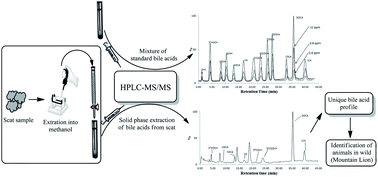
LC-MS for Animal Identification
Studying rare or endangered species of wild animals is no easy task. Analysis of animal tracks and fecal matter left behind can provide some clues for species identification, as well as insight into animal behavior and habitation. However, these identification signs are elusive, and often confounded by variations in environmental conditions, as well as animal health and diet. While methods of molecular analysis such as DNA sequence analysis of animal scat samples can provide more informative answers, DNA contamination from other mammals can make accurate identification difficult. To circumvent some of these limitations, Udaya Nasini, Ali Shaikh and colleagues from the University of Arkansas in Little Rock, USA, have demonstrated the use of liquid chromatography-mass spectrometry (LC-MS) to determine the composition of bile acids in scat samples. Analysis using LC-MS provides a metabolic pattern that is characteristic of a distinct species, and in turn enables effective identification.
Read more about this work by accessing the link below. This paper will be free to read for the next three weeks.
Let us know what your thoughts are by leaving a comment below!
Determination of bile acid profiles in scat samples of wild animals by liquid chromatography-electrospray mass spectrometry
Udaya B. Nasini, Nandan Peddi, Punnamchandar Ramidi, Yashraj Gartia, Anindya Ghosh and Ali U. Shaikh
Anal. Methods, 2013,5, 6319-6324
DOI: 10.1039/C3AY41048J










